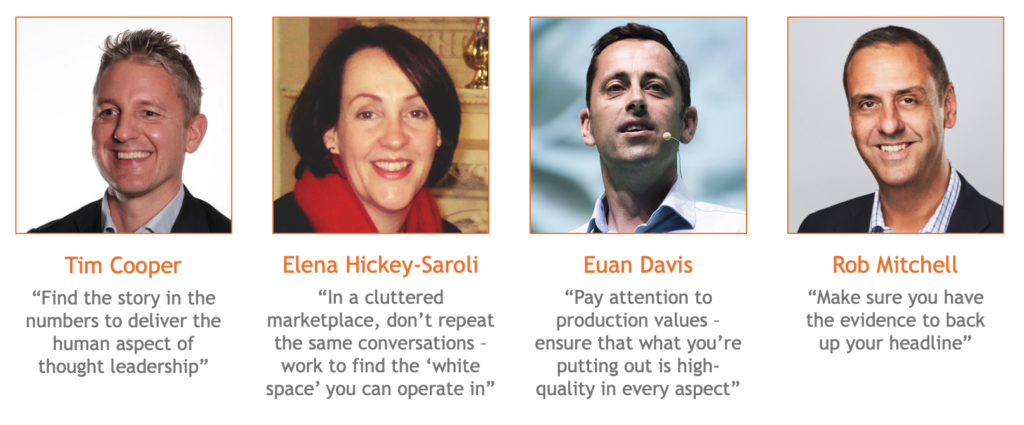Engaging the C-suite: first-hand insights from brands and agencies
In a highly competitive marketplace, how do you ensure your carefully constructed thought leadership content captures the attention of the C-suite?
That’s the question we put to a panel of senior thought leadership and marketing experts at our recent event.
The panel:
Representing both established brands and brand-builders in the thought leadership space, our panellists shared their perspectives and first-hand experience of trying to reach this elusive crowd.
The C-suite: a fast-moving target
FT Longitude CEO Rob Mitchell reminded us that the C-suite cohort remains a relatively small target audience for brands to engage with, and one which is over-served by a crowded market. Yet, the C-suite remains highly motivated: “There is definitely a demand for information. They’re operating in a world of rapid and profound change, in many different dimensions. And they need information and a fresh perspective to help them navigate that.”
Our latest research confirms this, indicating a strong appetite among business leaders for intelligent insight from brands – senior executives spend on average four hours a week consuming thought leadership content – but only if the insight speaks to their needs. Success depends on brands being able to offer evidence-based insight and practical solutions via a compelling narrative.
Elena Hickey Saroli, Audience Brand Leader at EY, believes that, now more than ever, speed to market is key: “We often have just six to eight weeks to have an opinion on something before that opinion is obsolete,” she confirms.
Mixing and shaking it up
Bringing ideas and insight together is a complex process, but one that firms need to execute efficiently in order to keep up with fast-moving events and position themselves at the cutting edge of thought leadership. The panel agreed that this all comes down to objectives.
Tim Cooper, Global Head of Strategic Communications at Dentsu Aegis, believes that a mixed model of both long-form research and quick deliverables can allow firms to make a lasting impression: “It allows you to stay relevant but also to have a longer-term perspective, which is the key function to thought leadership. While it’s important to weigh in on the big issues of the day, there’s a real opportunity to differentiate yourself by taking a step back and delivering a bit more perspective.”
But this has to be done in the right way. We’ve all read thought leadership that is bland, superficial or platitudinous. All too often, companies are scared of expressing a strong point of view; but, if they stay on the fence, they will find that their content simply does not resonate. To really stand out from the crowd, content must be stimulating and surprising.
On this point, Euan Davis, Assistant VP for the Center for the Future of Work EMEA at Cognizant, agrees. He believes you have to be prepared to shake audiences up a bit in order to initiate that all-important dialogue. “The challenge is to make the research provocative, and slightly uncomfortable for the C-suite to read.” This is an approach that has worked well for Cognizant. Euan explained how a series of linked pieces of thought leadership the tech consultancy has published recently, exploring key areas of investment for firms such as jobs and skills of the future, has resonated well with business leaders for whom legacy is top of mind.
The value of talking it through
On the final point of discussion, our panelists were united. For thought leadership to reach those at the top table, it needs to be grounded in a commercial conversation.
Despite the rise in social media and mobile consumption of content –a trend our research highlights – our panel of marketing and thought leadership mavens collectively trust in the power of face-to-face engagement.
At this year’s World Economic Forum at Davos in January, Dentsu Aegis witnessed the power of deep C-suite involvement. “We saw first-hand how C-level executives really value sitting next to someone who they otherwise wouldn’t have had the opportunity to speak to,” enthuses Cooper. “They’re all looking for an environment in which they can get a more diverse set of opinions and views. As the brand that creates this setting, I think that’s incredibly powerful and an effective way to position your organisation.”
Finally, we asked the panelists to share their top tip for producing thought leadership content that can win attention from the C-suite. Here’s what they said:
We’ll share more expert insight from our event through Q&As with each of our four panelists here on the blog over the coming weeks.
———————————————————————————————————————–
Based on a global survey of over 1000 senior executives and decision-makers across a range of industries, we reveal how this prestigious crowd discover, engage and respond to thought leadership content – including their most-wanted topics for 2019.
- Learn how the right thought leadership strategy can directly influence your audience’s decisions and create preference for your brand
- Find out which topics are in demand for different business decision-makers – and which topics are best avoided
- Explore how different executive personas prefer to consume content
- Explore the five myths of C-suite content – and how your business can avoid the big thought leadership traps.






 Back
Back

 Book a meeting
Book a meeting
 Book a meeting
Book a meeting



